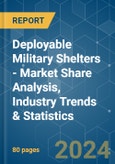The Deployable Military Shelters Market size is estimated at USD 0.97 billion in 2024, and is expected to reach USD 1.02 billion by 2029, growing at a CAGR of 1.14% during the forecast period (2024-2029).Prominent Market layers Include HDT Global, UTS Systems, General Dynamics Corporation, AAR, and Rubb Buildings
The COVID-19 pandemic did not significantly impact the deployable military shelters market. However, in certain countries, the military deployed temporary shelters to be used as temporary COVID-19 medical centers for quarantine and treatment purposes.
The evolving battlefield requirements have necessitated increased military units' deployment in far-away warzones and various diverse terrains for training and strategic operational purposes. Unrest across the borders with neighboring countries is generating the need for deployment of thousands of soldiers, which generates the need for portable military shelters.
Significant investments are being directed toward developing shelters with fewer parts, less weight, high tensile strength, and enhanced ease of fabrication and assembly. Advancements in designs and material technologies have resulted in the development of military shelters that are easy to transport and deploy and have a higher tolerance to extreme environments, which is further expected to accelerate the market's growth over the coming years.
Deployable Military Shelters Market Trends
Other Types Segment Accounted for a Major Market Share in 2021
The other types segment currently has the highest market share and is expected to continue its dominance during the forecast period. The segment includes relocatable storage units, deployable hangars, and custom-built temporary military housing units. Deployable hangars are fully demountable and relocatable and are designed to have the shortest assembly time. In most cases, all the materials can be reused, both structure and envelope, in the next assembly of the building. Veldeman is one of the leading suppliers of deployable hangars for the United Nations, NATO, US Air Force, Royal Australian Air Force, Belgian Air Force, Canadian Air Force, Chilean Air Force, Indian Air Force, etc. Besides being a prime supplier of deployable hangars, the company also offers full accessory packages, including aircraft and personnel doors, lights, ventilation, and HVAC systems. In May 2021, Saab received an order from the Bulgarian Air Force to deliver a Deployable Maintenance Facility (DAM). The DAM was planned to be deployed at multiple air bases throughout Bulgaria to complement existing permanent infrastructure. Such developments are expected to propel the segment's growth during the forecast period.Europe is Expected to Witness the Highest Growth During the Forecast Period
The European region is expected to record the highest CAGR during the forecast period. European forces are strategically deployed by NATO partner countries in different peacekeeping missions around the world. For instance, in 2019, the UK Ministry of Defence (MoD) provided a contract worth GBP 9.5 million (USD 12.8 million) to Rubb UK to procure and refurbish military shelters. The company was awarded the contract to provide services over a period of two years. Temporary shelters are used by the defense forces to set up medical camps and assist the wounded in war zones or affected areas during a pandemic. The COVID-19 pandemic triggered a multifold increase in demand for deployable military shelters. In March 2020, the French Army set up a military field hospital to relieve the pressure on the ICU of the main hospital in the eastern French city of Mulhouse. The field hospital could admit up to 30 patients in intensive care. Similarly, several field hospitals have cropped up in Russia as the infection rate increased in the country. For instance, in May 2020, the Russian military opened a field hospital with a 100-bed capacity to treat COVID-19 patients in the North Caucasus region of Dagestan. A similar facility was also set up in the Murmansk region. Such developments are expected to propel the market's growth over the coming years.Deployable Military Shelters Industry Overview
The deployable military shelter market is highly fragmented and highly competitive, with competition from military fabric manufacturers, military equipment manufacturers, sports gear manufacturers, and extreme weather shelter manufacturing companies. UTS Systems, General Dynamics Corporation, AAR Corp., Saab AB, and HDT Global are some of the market's major players. The smaller players that have risen due to the spike in demand in 2020 are expected to remain in the market for another 3-4 years, with only about 50% of these players surviving beyond the 5-year period when profits start to decline, and costs start to catch up. Major players planning to expand their presence globally should wait out these next 2-3 years to acquire small domestic firms or form JVs and partnerships with these companies to reduce risks and costs by taking the dominant role in the business. The manufacturers of deployable military shelters are continually looking for ways to develop shelters that can withstand a wide range of harsh weather conditions, keeping in mind the various defense authorities' certification requirements across the world. This will help manufacturers gain new contracts from the militaries and expand their market share during the forecast period.Additional Benefits:
- The market estimate (ME) sheet in Excel format
- 3 months of analyst support
This product will be delivered within 2 business days.
Table of Contents
1 INTRODUCTION
3 EXECUTIVE SUMMARY
4 MARKET DYNAMICS
5 MARKET SEGMENTATION (Market Size and Forecast by Value - USD million, 2018 - 2031)
6 COMPETITIVE LANDSCAPE
Companies Mentioned (Partial List)
A selection of companies mentioned in this report includes, but is not limited to:
- UTS Systems
- General Dynamics Corporation
- AAR CORP.
- Rubb Buildings Ltd
- Saab AB
- HDT Global
- Litefighter Systems LLC
- Losberger GmbH
- Weatherhaven Global Resources Ltd
- Eureka! Expeditionary Systems
- RDD USA
- Federal-Fabrics-Fibers Inc.
- Camel Manufacturing
Methodology

LOADING...










